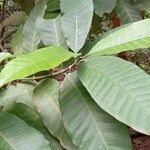Small tree or shrub 1.5–15 m high, trunk 5–30 cm in diameter; bark pale brown, corky, fissured.. Leaves petiolate; blade elliptic or narrowly elliptic, 6–23 cm long, 2–8 cm wide, apex acute, obtuse or acuminate, cuneate at the base or decurrent into the petiole, occasionally pubescent beneath; petiole 7–30 mm long.. Inflorescence 5–20 cm long, many-flowered, lax, glabrous or occasionally with scattered short hairs in all parts; peduncle 1–8.5 cm long; pedicels 2–6 mm long.. Flowers with sepals suborbicular to broadly ovate, 1.2–2.5 mm long, 1.2–2.5 mm wide, rounded; corolla creamy or pale yellow, white distally; tube almost cylindrical, not twisted, 5–7 mm long; lobes spreading, obliquely elliptic, slightly falcate, 8–15 mm long, 3–7 mm wide, rounded, subauriculate at the left side of the base, entire; stamens with apex 1–2 mm below the mouth of the corolla tube, inserted 2–2.7 mm above the corolla base; pistil 3.5–4.2 mm long, glabrous; ovary up to 1.6 mm long; ovules 35–60 in each carpel.. Fruit green, with conspicuous pale brown warts, obliquely ovoid or ellipsoid, 5–8 cm long, 4–6.5 cm in diameter, apiculate, 3–ridged; pericarp 5–15 mm thick; aril orange; seeds dark brown, coffee-bean-like, 14–15 mm long, reticulately grooved, papillose.
A small tree. It grows 3-5 m tall. It can reach 10 m tall. The bark is thick and pale cream. It is corky and deeply cracked. The small branches have tough stringy bark. The leaves are oblong and 9-20 cm long by 5-7 cm wide. They are thinly leathery, The are glossy dark green above and paler underneath. The flowers are white to cream and 2.5 cm across. They occur in loose heads in the axils of leaves or at the ends of branches. The fruit are paired. Each section is almost round and joined at the base. They are 6-7 cm long by 4-5 cm wide. They are ridged with the tip turned down into a beak. They are dark green dotted with pale grey warts. They split when mature to expose bright orange pulp with many brown seeds. The pulp is edible.
Corolla white, creamy, or pale yellow, in the mature bud 8·5–15 mm. long incl. the lobes (the lobes 1/3 –c.1/2 of the length of the bud and 3·5–8 x 3·5–6 mm., forming a broadly ovoid head with a blunt apex), glabrous or occasionally with some small hairs outside, inside with a densely pubescent belt from the insertion of the stamens to the mouth; tube 2·5–4 times as long as the calyx, 5–7 mm. long, almost cylindrical and 1·8–2·4 mm. wide, not twisted, slightly contracted at both the base and just below the insertion of the stamens, widened at the throat; lobes slightly falcate, 1·3–2·5 times as long as the tube, 1·5–3·3 times as long as wide, 8–15 x 3–7 mm., rounded, subauriculate at the left side of the base, entire.
Leaves petiolate; petiole glabrous, 7–30 mm. long; lamina coriaceous (also when fresh) variable in size, elliptic to narrowly elliptic, 2–4 times as long as wide, (4)5·5–23 x (1)2–8 cm., acuminate with an often blunt point or acute or obtuse, with the base cuneate or decurrent into the petiole, entire, glabrous on both surfaces or occasionally pubescent beneath; secondary veins 12–23 on either side of the midrib, straight except for the upcurved apex, fish-bone-like, forming an angle of 70–90° with the midrib, anastomosing towards the apex; tertiary venation reticulate, especially conspicuous in old leaves.
Pistil glabrous, 3·5-4·2 mm. long; ovary subglobose to almost cylindrical, laterally compressed, 1·2–1·6 x 1·2–1·4 x 1–1·2 mm.; style 1–1·2 x 0·2 mm., widened at the apex; clavuncula composed of two rings: a narrow basal one, 0·5–0·8 x 0·1 mm. and a wider apical one, 0·3–0·4 x 0·5–0·6 mm. gradually narrowing into the slender (0·5)1 mm. long erect stigma.
Sepals pale green, almost free, subcircular or broadly ovate, 0·8–1 times as long as wide, 1·2–2·5 x 1·2–2·5 mm., glabrous or occasionally pubescent outside, inside at the base with a single row of colleters (this may be interrupted and restricted to groups of 3–4, sometimes basally united ones), rounded, erect.
Mericarps separate, glaucous or green, with conspicuous pale brown warts, obliquely ovoid or ellipsoid, 5–8 x 4–6·5 x 4–5 cm., apiculate, with 3 ridges, two lateral and one abaxial (these more pronounced in dried fruits), 2-valved, several-seeded; wall 5–15 mm. thick; aril orange.
Branches with a pale brown corky longitudinally fissured bark and transverse ridges caused by leaf scars, with scattered lenticells of the same colour; branchlets glabrous.
Small tree or shrub, up to 8 m high. Corolla tube up to 1.5 mm in diameter. Calyx 1.5-2.0 mm long. Fruit warty. Flowers white.
Seeds dark brown, dull, 14–15 x 7–9 x 6–7 mm., with reticulate grooves making a brain-like surface, minutely tuberculate.
Stamens included for 1–2 mm., inserted 2–2·7 mm. above the corolla-base; anthers 2–2·5 x 0·6–0·7 mm., glabrous.
Small tree or shrub, 1·5–12 m. high; trunk terete, 5–30 cm. in diam.; bark pale brown, corky, deeply fissured.
Bracts scale-like, about as long as the sepals, soon dedicuous, with a single row of colleters in the axils.
Peduncle glabrous or occasionally with scattered short hairs, 1–8·5 cm. long, rather slender.
Inflorescences short-or long-pedunculate, 5–20 x 5–15 cm., usually many-flowered, lax.
Pedicels glabrous or occasionally with scattered short hairs, 2–6 mm. long.
Ovules c. 35-60 in each carpel.
Flowers sweet-scented.


